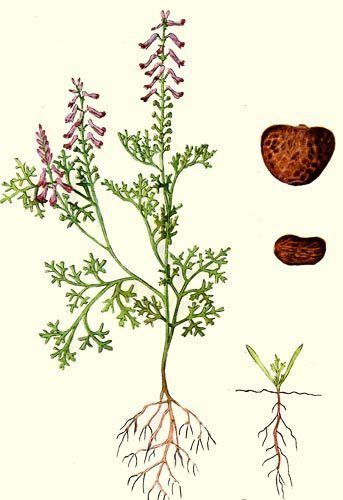Rank Species | Higher classification Fumaria | |
 | ||
Similar Fumaria, Chicory, Cleavers, Sinapis arvensis, Common Chickenweed | ||
Fumaria officinalis
Fumaria officinalis (common fumitory, drug fumitory or earth smoke) is a herbaceous annual flowering plant in the poppy family Papaveraceae It is the most common species of the genus Fumaria in Western and Central Europe.
Contents
- Fumaria officinalis
- Common fumitory fumaria officinalis earth smoke 2012 06 02
- Description
- Etymology
- Herbalism
- Chemical constituents
- References

Common fumitory fumaria officinalis earth smoke 2012 06 02
Description

It is an herbaceous annual plant, which grows weakly erect and scrambling, with stalks about 10 to 50 cm long. Its pink 7 to 9 mm flowers appear from April to October in the northern hemisphere. They are two lipped and spurred, with sepals running a quarter the length of the petals. The fruit is an achene. It contains alkaloids, potassium salts, and tannins. It is also a major source of fumaric acid.
Etymology

The "smoky" or "fumy" origin of its name comes from the translucent color of its flowers, giving them the appearance of smoke or of hanging in smoke, and the slightly gray-blue haze color of its foliage, also resembling smoke coming from the ground, especially after morning dew.

The plant was already called fūmus terrae (smoke of the earth) in the early 13th century, and two thousand years ago, Dioscorides wrote in De Materia Medica (Περὶ ὕλης ἰατρικῆς) and Pliny the Elder in Naturalis Historia that rubbing the eyes with the sap or latex of the plant causes tears, like acrid smoke (fūmus) does to the eyes. Its Greek name is kapnos (καπνός, for smoke) and the name fumewort now applies mostly to the genus Corydalis, especially the similar looking Corydalis solida (formerly Fumaria bulbosa), which was thought to belong to the same genus as fumitory.
Herbalism
It was traditionally thought to be good for the eyes, and to remove skin blemishes. In modern times herbalists use it to treat skin diseases, and conjunctivitis; as well as to cleanse the kidneys. However, Howard (1987) warns that fumitory is poisonous and should only be used "under the direction of a medical herbalist."
Chemical constituents
The plant contains isoquinoline alkaloids protopine and allocryptopine. Both protopine and allocryptopine increased CYP1A1 and CYP1A2 mRNA levels in human hepatocyte cells. The use of products containing protopine and/or allocryptopine may be considered safe in terms of possible induction of CYP1A enzymes.
